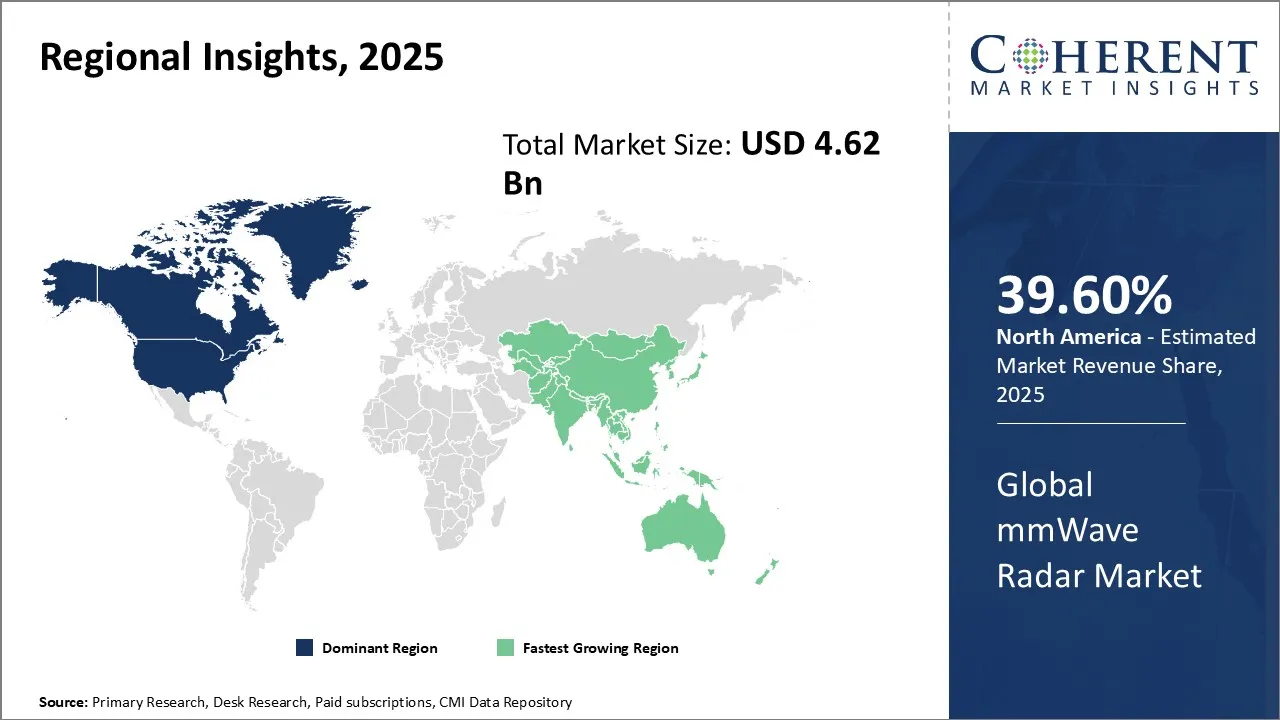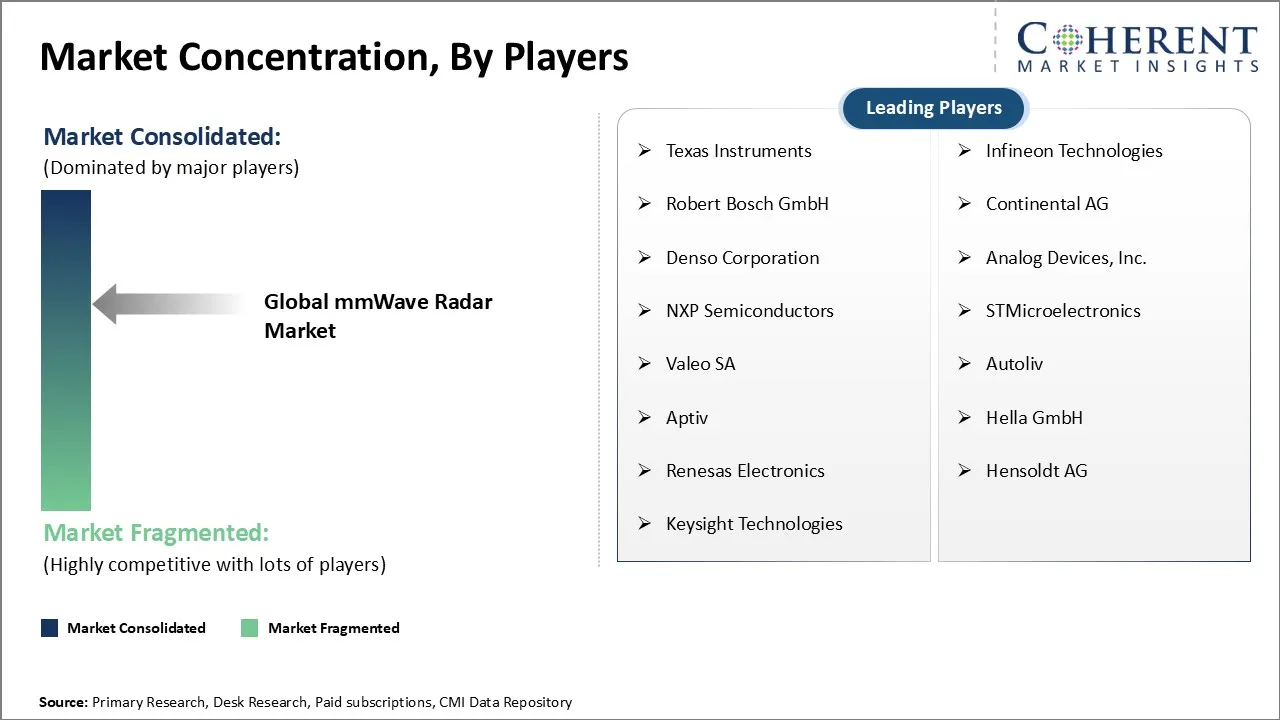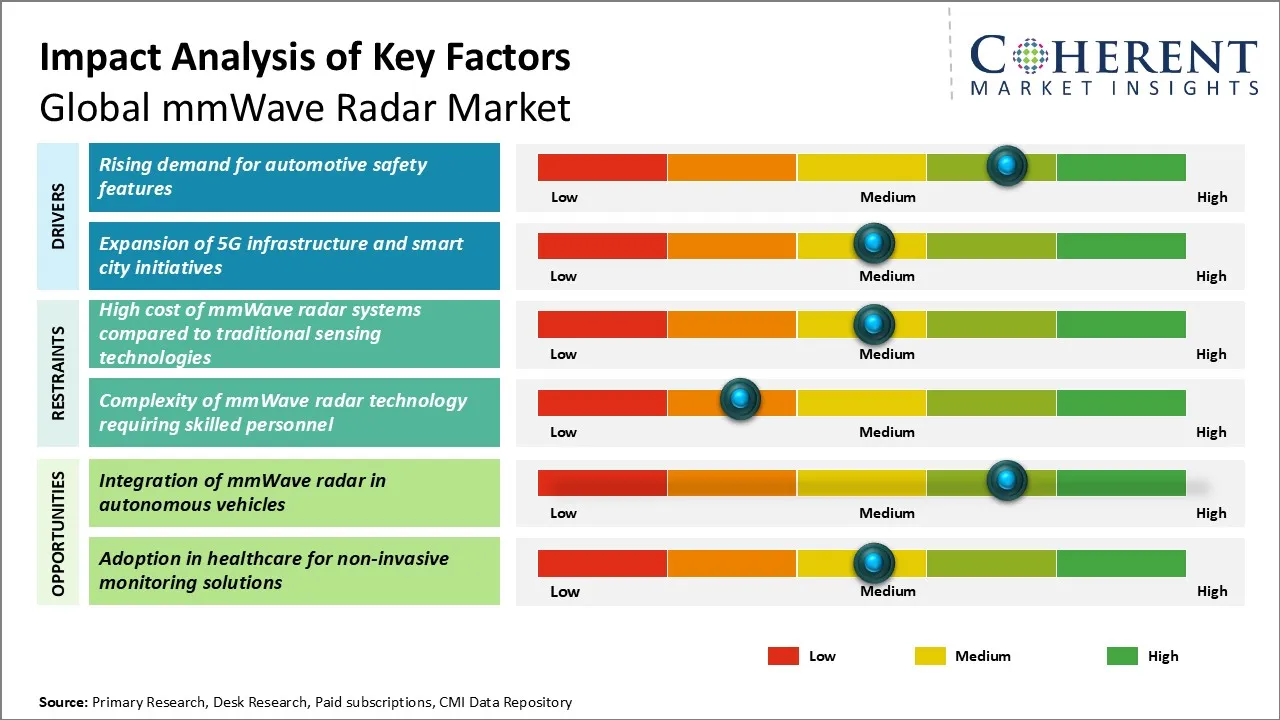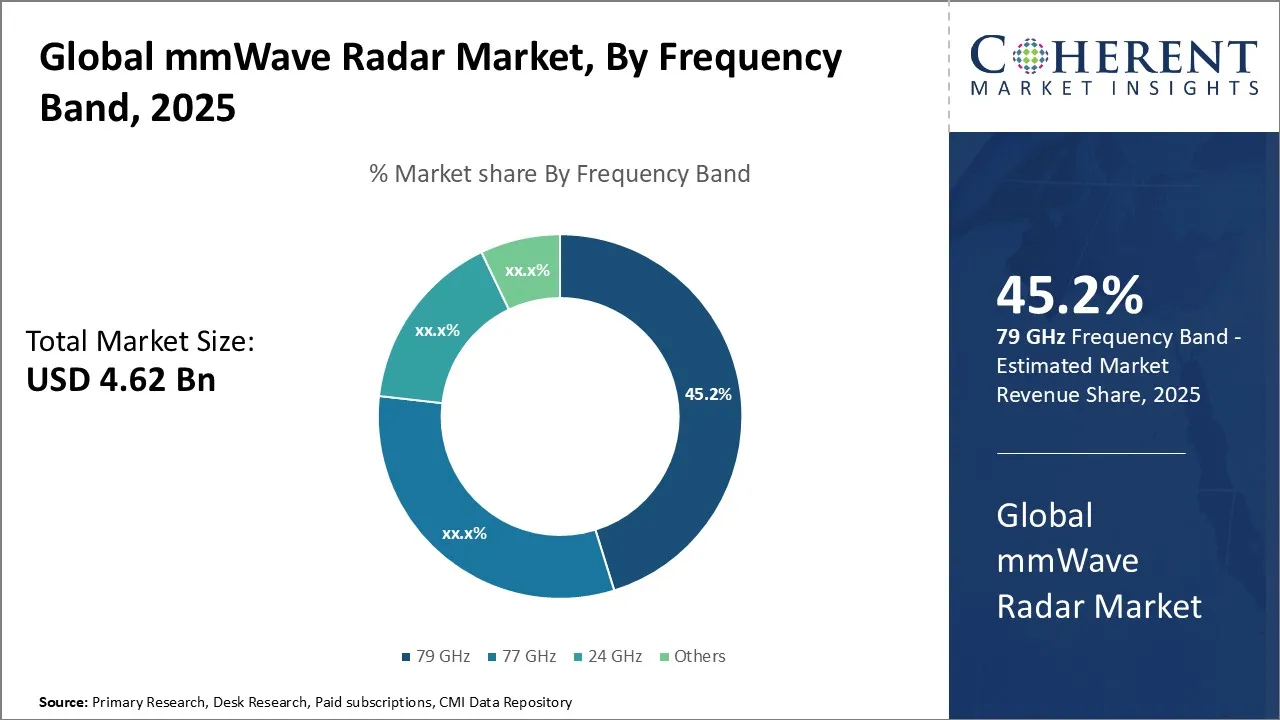Global mmWave Radar Market Size and Forecast – 2025-2032
The Global mmWave Radar Market is estimated to be valued at USD 4.62 Bn in 2025 and is expected to reach USD 18.16 Bn by 2032, exhibiting a compound annual growth rate (CAGR) of 21.6% from 2025 to 2032.
Key Takeaways of the Global mmWave Radar Market:
- The 79 GHz segment leads the market holding an estimated share of 45.2% in 2025.
- The Automotive Safety Systems segment is estimated to lead the market with a share of 51.4% in 2025.
- North America is estimated to lead the market with a share of 39.6% in 2025. Asia Pacific, holding a share of 34.7% in 2025, is projected to be the fastest growing region.
Market Overview
The mmWave radar market is seeing the development of high-resolution radar systems, use of artificial intelligence and machine learning algorithms for improved object detection and classification, and miniaturization of radar components to improve portability and cost-effectiveness. To add, there is a lot of focus on smart cities and intelligent transportation systems, which is likely to add to the adoption of mmWave radar technology in the coming years.
Current Events and Its Impact
|
Current Events |
Description and its impact |
|
Escalation of Global Chip Shortages and Semiconductor Supply Challenges |
|
|
Geopolitical Tensions and Trade Restrictions |
|
Uncover macros and micros vetted on 75+ parameters: Get instant access to report
Global mmWave Radar Market Insights, by Frequency Band - 79 GHz Leads Due to its Superior Performance and Regulatory Support
The 79 GHz segment has emerged as the dominant segment in the global mmWave radar market, holding an estimated share of 45.2% in 2025. 79 GHz radar offers a wider bandwidth compared to other mmWave frequencies, making possible the development of radar systems with improved range resolution and accuracy. Also, regulatory bodies in different regions, including Europe and the U.S., have allocated the 79 GHz band for automotive radar applications. To add, there is an increased demand for advanced driver assistance systems (ADAS) and autonomous vehicles, adding to the adoption of 79 GHz radar. Long-range radar systems, with the 79 GHz frequency band, can detect objects at greater distances, making it useful for applications such as adaptive cruise control, collision avoidance, and automated emergency braking.
Global mmWave Radar Market Insights, by Application – Automotive Safety Systems Lead Due to Increasing Demand for Advanced Driver Assistance Systems (ADAS)
The automotive safety systems segment, holding an estimated share of 51.4% in 2025, has emerged as the largest contributor to the global mmWave radar market, primarily driven by the growing demand for advanced driver assistance systems (ADAS) and the development of autonomous vehicles. The increasing emphasis on road safety and the implementation of stringent safety regulations have further propelled the adoption of mmWave radar in automotive safety systems. Governments and regulatory bodies worldwide are mandating the inclusion of advanced safety features in vehicles, such as automatic emergency braking and forward collision warning.
Role of Artificial Intelligence (AI) in the Market
Artificial Intelligence (AI) is playing a transformative role in the global mmWave radar market by significantly enhancing the precision, adaptability, and responsiveness of radar systems across applications. Traditional mmWave radar systems rely on static signal processing algorithms, but AI enables dynamic interpretation of radar signals through machine learning models that can adapt to diverse environmental conditions and use cases. In automotive applications, for instance, AI-powered mmWave radars can better distinguish between a stationary object and a moving pedestrian in complex traffic scenarios, thereby reducing false positives and enhancing vehicle safety systems like Adaptive Cruise Control (ACC) and Automated Emergency Braking (AEB).
Infineon Technologies collaborates with automotive OEMs to develop AI-enhanced radar sensors that support Level 3 autonomous driving. These sensors use neural networks to analyze reflected waveforms in real time, enabling vehicles to "learn" road patterns, predict pedestrian behavior, and recognize partially obstructed objects.
Regional Insights

To learn more about this report, Download Free Sample
North America mmWave Radar Market Analysis and Trends
North America, holding a share of 39.6% in 2025, is expected to dominate the global mmWave radar market. The region boasts a well-established market ecosystem, with a strong presence of key players and a robust supply chain. The U.S., in particular, has been at the forefront of technological advancements in the mmWave radar industry, driven by significant investments in research and development. Moreover, the region's stringent safety regulations and increasing adoption of advanced driver assistance systems (ADAS) in the automotive sector have further propelled the demand for mmWave radar technology. Notable companies, such as Texas Instruments, Infineon Technologies, and Qualcomm, have played a pivotal role in shaping the market landscape in North America through their innovative offerings and partnerships with original equipment manufacturers (OEMs).
Asia Pacific mmWave Radar Market Analysis and Trends
The Asia Pacific region, holding a share of 34.7% in 2025, is expected to exhibit the fastest growth in the global mmWave radar market. The region's rapid economic development, coupled with increasing urbanization and rising disposable incomes, has fueled the demand for advanced automotive technologies, including mmWave radar systems. Countries like China, Japan, and South Korea have emerged as major manufacturing hubs for automotive components and electronics, attracting significant investments from global players. The governments in these countries have also implemented favorable policies and initiatives to promote the adoption of advanced safety features in vehicles, further driving the growth of the mmWave radar market. Additionally, the expanding aerospace and defense sectors in countries like India and China have contributed to the increased demand for mmWave radar technology in the region. Companies such as Denso Corporation, Mitsubishi Electric Corporation, and Hyundai Mobis have been instrumental in driving innovation and market growth in the Asia Pacific.
Global mmWave Radar Market Outlook for Key Countries
U.S. mmWave Radar Market Analysis and Trends
The U.S. mmWave radar market is highly advanced and mature, with a strong focus on automotive applications. The country's stringent safety regulations, such as the Federal Motor Vehicle Safety Standards (FMVSS), have driven the adoption of advanced driver assistance systems (ADAS) and autonomous driving technologies. Major automotive manufacturers and tier-1 suppliers in the U.S. have been actively integrating mmWave radar into their vehicles to enhance safety features and enable higher levels of automation. The market is characterized by intense competition among key players, with a strong emphasis on innovation and partnerships with technology providers.
China mmWave Radar Market Analysis and Trends
China mmWave radar market has experienced significant growth in recent years, driven by the country's rapidly expanding automotive industry and increasing demand for advanced safety features. The Chinese government's initiatives to promote electric vehicles and autonomous driving have further accelerated the adoption of mmWave radar systems. Local companies, such as Huawei and BYD, have been actively investing in the development of mmWave radar technology, while international players have established partnerships and joint ventures to tap into the vast potential of China mmWave radar market. The market is expected to witness substantial growth in the coming years, supported by favorable government policies and increasing consumer awareness.
Japan mmWave Radar Market Analysis and Trends
Japan continues to lead the way in the development and commercialization of mmWave radar technology, particularly in the automotive sector. The country's renowned automotive manufacturers, such as Toyota, Honda, and Nissan, have been at the forefront of integrating advanced radar systems into their vehicles. Japan mmWave radar market is characterized by a strong focus on innovation, with companies investing heavily in research and development to enhance the performance and reliability of mmWave radar technology. The government's commitment to promoting safe and sustainable transportation has further supported the growth of the market. Additionally, Japan's expertise in semiconductor manufacturing has positioned the country as a key supplier of mmWave radar components to the global market.
Germany mmWave Radar Market Analysis and Trends
Germany mmWave radar market is primarily driven by the country's strong automotive industry and its focus on advanced driver assistance systems (ADAS) and autonomous driving. German automotive giants, such as Volkswagen, BMW, and Daimler, have been actively incorporating mmWave radar into their vehicles to enhance safety and enable higher levels of automation. The country's well-established research and development ecosystem, coupled with its skilled workforce, has fostered innovation in the mmWave radar market. Additionally, Germany's stringent vehicle safety regulations and increasing consumer awareness have further propelled the adoption of advanced radar technology in the automotive sector.
Market Players, Key Development, and Competitive Intelligence

To learn more about this report, Download Free Sample
Key Developments
- In January 2025, Logitech introduced "Logitech Spot," a peel-and-stick mmWave radar sensor for office occupancy and environmental monitoring
- In March 2021, GlobalFoundries (GF), the global leader in specialty semiconductor manufacturing, and Bosch partnered to develop and manufacture next-generation automotive radar technology.
- Bosch chose GF as its partner to develop a mmWave automotive radar system-on-chip (SoC) for Advanced Driver Assistance Systems (ADAS) applications, manufactured using GF’s 22FDX RF solution.
- In March 2021, Keysight Technologies, Inc. (NYSE: KEYS), a leading technology company that delivers advanced design and validation solutions to help accelerate innovation to connect and secure the world, announced that Keysight and Aview have joined forces to establish a millimeter wave radar laboratory to be located in Suzhou, China
- In February 2021, an integrated millimeter-wave (mmWave) radar-sensing solution, based on Infineon's XENSIV mmWave radar chip was launched by Arrow Electronics.
Top Strategies Followed by Global mmWave Radar Market Players
- Established players are investing heavily in R&D to develop advanced radar systems with improved range, accuracy, and resolution.
- Texas Instruments’ IWR and AWR series of single-chip radar sensors integrate DSP and MCU cores to deliver high-resolution sensing.
- Mid-level players are concentrating on delivering cost-effective solutions to target price-sensitive consumers by optimizing their production processes and leveraging economies of scale.
- Uhnder uses digital code modulation (DCM) and leverages fabless semiconductor manufacturing models to offer high-performance radar sensors at lower costs.
- Small-scale players are targeting specific market segments with unique features or innovative solutions.
- Smartmicro specializes in traffic management and smart city applications, offering radar sensors tailored for intersection monitoring, wrong-way detection, and pedestrian safety in urban environments
Market Report Scope
mmWave Radar Market Report Coverage
| Report Coverage | Details | ||
|---|---|---|---|
| Base Year: | 2024 | Market Size in 2025: | USD 4.62 Bn |
| Historical Data for: | 2020 To 2024 | Forecast Period: | 2025 To 2032 |
| Forecast Period 2025 to 2032 CAGR: | 21.6% | 2032 Value Projection: | USD 18.16 Bn |
| Geographies covered: |
|
||
| Segments covered: |
|
||
| Companies covered: |
Texas Instruments, Infineon Technologies, Robert Bosch GmbH, Continental AG, Denso Corporation, Analog Devices, Inc., NXP Semiconductors, STMicroelectronics, Valeo SA, Autoliv, Aptiv, Hella GmbH, Renesas Electronics, Hensoldt AG, and Keysight Technologies |
||
| Growth Drivers: |
|
||
| Restraints & Challenges: |
|
||
Uncover macros and micros vetted on 75+ parameters: Get instant access to report
Market Dynamics

To learn more about this report, Download Free Sample
Global mmWave Radar Market Driver - Rising Demand for Automotive Safety Features
As consumers become more aware of the importance of vehicle safety, automakers are integrating mmWave radar technology into their vehicles to enhance driver assistance systems and improve overall safety. These radar systems enable features such as adaptive cruise control, blind-spot detection, collision avoidance, and automated emergency braking, which not only provide a safer driving experience but also reduce the risk of accidents on the road.
Moreover, government regulations and safety standards are becoming more stringent, further pushing the adoption of mmWave radar technology in the automotive sector. As a result, the rising demand for automotive safety features is expected to continue driving the growth of the global mmWave radar market in the coming years.
Global mmWave Radar Market Opportunity: Integration of mmWave Radar in Autonomous Vehicles
As the automotive industry rapidly advances towards self-driving cars, the demand for robust and reliable sensing solutions is skyrocketing. mmWave radar systems offer unique advantages that make them well-suited for autonomous vehicle applications. With their ability to provide high-resolution, long-range detection and accurate object tracking, mmWave radar enables vehicles to perceive and navigate their surroundings safely. These systems can operate in various weather conditions, including fog, rain, and snow, ensuring reliable performance even in challenging environments.
Analyst Opinion (Expert Opinion)
- While mmWave radar has long been central to external safety features like Adaptive Cruise Control (ACC) and Blind Spot Detection (BSD), its frontier is shifting inward. Automakers are now integrating mmWave sensors for in-cabin monitoring—detecting driver fatigue, child presence, and even passenger biometrics. These systems are becoming essential as regulators push for advanced occupant safety standards (e.g., Euro NCAP's 2025 roadmap).
- Hospitals and eldercare facilities are beginning to adopt mmWave radar for non-intrusive vital sign monitoring—like breathing rate and heart rhythm—without requiring wearables. This technology shows promise in early warning systems for fall detection, sleep apnea, and even emotional stress tracking, especially in post-acute and remote care settings.
- City planners and facility managers are using mmWave radar to monitor pedestrian movement, traffic flow, and environmental changes. Compared to cameras or LIDAR, radar offers privacy advantages and better performance in poor visibility. Expect mmWave sensors to be foundational in smart traffic lights, intelligent buildings, and next-gen public surveillance.
Market Segmentation
- Frequency Band Insights (Revenue, USD Bn, 2020 - 2032)
- 79 GHz
- 77 GHz
- 24 GHz
- Others
- Application Insights (Revenue, USD Bn, 2020 - 2032)
- Automotive Safety Systems
- Drones & Robotics
- Industrial Automation
- Smart Infrastructure
- Others
- Regional Insights (Revenue, USD Bn, 2020 - 2032)
- North America
- U.S.
- Canada
- Latin America
- Brazil
- Argentina
- Mexico
- Rest of Latin America
- Europe
- Germany
- U.K.
- Spain
- France
- Italy
- Russia
- Rest of Europe
- Asia Pacific
- China
- India
- Japan
- Australia
- South Korea
- ASEAN
- Rest of Asia Pacific
- Middle East
- GCC Countries
- Israel
- Rest of Middle East
- Africa
- South Africa
- North Africa
- Central Africa
- North America
- Key Players Insights
- Texas Instruments
- Infineon Technologies
- Robert Bosch GmbH
- Continental AG
- Denso Corporation
- Analog Devices, Inc.
- NXP Semiconductors
- STMicroelectronics
- Valeo SA
- Autoliv
- Aptiv
- Hella GmbH
- Renesas Electronics
- Hensoldt AG
- Keysight Technologies
Sources
Primary Research Interviews
Stakeholders
- Automotive OEM Radar Engineers (e.g., ADAS Developers, Radar System Architects)
- mmWave Chip Manufacturers and System Integrators (e.g., RFIC Designers, System Engineers)
- Industrial Automation Firms Using mmWave Technology
- Telecommunication Equipment Providers (for 5G infrastructure and beyond)
- Robotics and Drone Developers utilizing mmWave sensors
- Smart City Program Managers and Urban Mobility Technologists
Databases
- Global Technology & Innovation Portal
- National Radar and Sensor Observatory (NRSO)
- Asia-Pacific Industry Intelligence Bureau (APIIB)
- Federal Wireless Systems Registry (FWSR)
Magazines
- Radar & Sensor Technology Weekly
- Advanced Driver Assistance Systems Digest (ADAS Digest)
- Autonomous Future Journal
- NextGen Connectivity Review
Journals
- Journal of Applied Electromagnetic Engineering
- IEEE Sensors Radar Systems Bulletin
- International Journal of Millimeter-Wave Innovation
- AI & Robotics Signal Processing Journal
Newspapers
- The Tech Observer (U.S.)
- Asia Signal Times (Singapore)
- EuroRadar Daily (Germany)
- The Innovation Chronicle (Global)
Associations
- Global mmWave Technology Council (GmWTC)
- Advanced Driver Assistance Systems Association (ADAS-A)
- International Association of RF and mmWave Engineers (IARME)
- NextGen Automotive Radar Consortium (NGARC)
- Smart Infrastructure & Sensor Systems Alliance (SISSA)
Public Domain Sources
- U.S. Census Bureau
- EUROSTAT
- United Nations Economic Commission for Europe (UNECE)
- World Bank
- ResearchGate
Proprietary Elements
- CMI Data Analytics Tool
- Proprietary CMI Existing Repository of Information for Last 8 Years
Share
Share
About Author
As an accomplished Senior Consultant with 7+ years of experience, Pooja Tayade has a proven track record in devising and implementing data and strategy consulting across various industries. She specializes in market research, competitive analysis, primary insights, and market estimation. She excels in strategic advisory, delivering data-driven insights to help clients navigate market complexities, optimize entry strategies, and achieve sustainable growth.
Missing comfort of reading report in your local language? Find your preferred language :
Transform your Strategy with Exclusive Trending Reports :
Frequently Asked Questions
EXISTING CLIENTELE
Joining thousands of companies around the world committed to making the Excellent Business Solutions.
View All Our Clients


